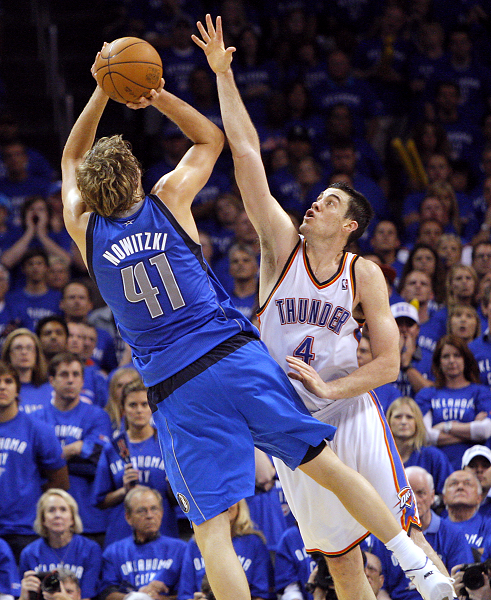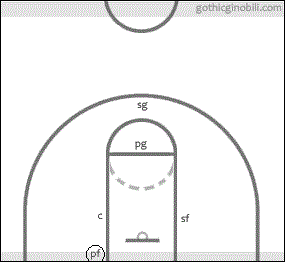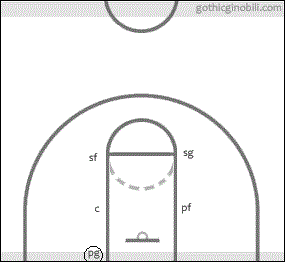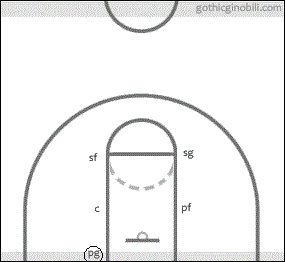Juwan a Book? #1: 101 Basketball Out-of-Bounds Drills
Posted on Sun 29 January 2012 in Juwan a Blog? by Alex Dewey
Lately I've been reading George Karl's 101 Basketball Out-of-Bounds Drills. This is a virtually unavailable book from 1999: I only found it through the Borgesian library of the Internet's darker channels. It's not impossible to find, but if (work with me here) 100 of you went out and bought it, I feel like that would actually prevent the next 100 of you from trying to get it. But despite this, I think Karl's book is worth talking about, if only as a lead-in to talking about halfcourt offense as a whole. After all, the book delivers exactly what its title promises, nothing more, nothing less -- the whole thing is about 115 pages long, and about 14 of those pages are non-drill pages, if you catch my drift. And while each of these pages contains a "drill," the drills are mostly full, workable descriptions of set plays with a couple extremely helpful diagrams per description.
• • •
As an exercise, I turned off all of the lights last night (last night when I wrote this, i.e. December 3) and got into an improvisational reverie and just tried to visualize and memorize a few of the inbounds plays. After doing so - despite the sparse nature of the book's coverage (I run through a couple of the plays below) - I was able to formulate some general principles from what I'd read. Some of the mostly implicit principles behind the plays were:
- Have a "safe" option on the wing in case the play (or even the initial inbounds pass) fails. Kind of obvious in retrospect; if you're coming out of a timeout you don't want a 24-second violation or even a turnover.
- Use a screen or an unscreened flare-out to the corner in order to create space for the inbounds pass.
- Use screens constantly to force mismatches and confusion, and realize how powerful rolling towards the basket off a pick is, even when neither player has the ball (as in a P&R). It's the old wisdom: "If you want to get open, set a screen," presented in its full generality.
- Use v-cuts and backdoors with quicker, smaller players in order to keep the defense honest and positioned to the offense's advantage.
- Use motion across and down the lane in order to force the defense to make bad or inconsistent switches that the offense can exploit for an easy path to the rim.
- As in folk basketball wisdom, the inbounder is extremely dangerous and useful to an inbounds play, but this is only true if the other four players can create the spacing or the screens to allow him to work after he comes inbounds, and only if he's actually suited and prepared for the action called for by the play (usually Karl seems to use PGs when he needs a lot of motion by an inbounding player).
- Passing the ball around the perimeter is powerful and works to the advantage of 3-point shooting teams and dominant driving players. Having great passing big men (like Tim Duncan) and oversized points (like Andre Miller) is a huge competitive advantage on inbounds plays, enabling lobs and post-ups that use their extra skills, which the defense must compensate for or (to the bane of every defense) simply must allow to happen.
And so on. There are so many little tidbits of understanding, so much domain expertise encoded in these diagrams and descriptions. I'm sure this is obvious to many of you that played basketball for your high school or college. But for those of us that played gritty street ball at recess, this book (and no doubt, the hundreds of others like it) is a revelation.
One of my biggest concrete takeaways is that, in sheer basketball terms, Dirk is an offensive coach's dream, and the book demystified to an extent Dirk's apparently miraculous comebacks these playoffs. With all of the marginal advantages Dirk has, both in iso and two-man plays, it's little bit less of a wonder that a loaded staff, an experienced supporting cast, and Dirk's basketball knowledge were able to beat the all-world Heat defense so consistently at the ends of games.
But Dirk's just a concrete example of why Karl's book fascinates me: Making and defending an inbounds play near a team's own basket sort of captures the whole problem of team basketball in a short microcosm of process, with fewer passes, seconds, opportunities, and with a much smaller margin for error on everyone's part. The competitive processes of inbounds plays don't of course match exactly those of team basketball as a whole. No, it's not a perfect microcosm. And there are plenty of elements of basketball that the inbounds play doesn't really cover: Transition, iso plays, rebounding, and perimeter passing come to mind. All of these form tangential considerations in an inbounds play. But just as in team basketball as a whole, the basic process of moving the ball and getting a good shot is the central question.
As with basketball as a whole, an inbounds play gives the advantage - the serve, so to speak - to the offense. However, just like basketball as a whole, this advantage is marginal and contextual. What's more, any number of factors such as poor execution, a lagging fifth player, great defensive rotations, and a bad matchup can instantly and rather decisively tip the scales towards the defense. To ensure that the players have a chance to win the serve, Karl's plays deploy all possible resources: Aside from last-second plays, spot-up shots and quick lobs, Karl uses at least 3 players actively. Most of the plays use 4, and quite a few use 5. It's fair to say that all the drills covered use all five players at least as decoys and for spacing purposes. I mean, most of the plays use 3 players just on the inbounds pass, much less the play as a whole. So these drills really do encapsulate the problem of committing totally to an offensive possession.
Above, I sketched the general principles of all of the plays in the book, but reading that bulleted list again, I note there's a principle I'm still missing. It's of the more abstract variety and it goes like this: Through a decent amount of practice, dedication, focus, and intelligence, a normal, decent offensive team can take on a normal, decent defense, and - through a topology of holes in time and space created at the moments when defensive players must decide to switch - can utterly destroy that defense.
• • •
Drill #53
Now let's go through a couple of drills. We're gonna start out nice and easy with this first drill, and by the end we're going to be nice... and rough (yes, I'm referencing Tina Turner's spoken-word intro to "Proud Mary"). For each of these drills I'm going to show you an image copy of the page, my thoughts, and a gif sequence showing the options of the play that I made from the diagram. Warning: gifs may be canon.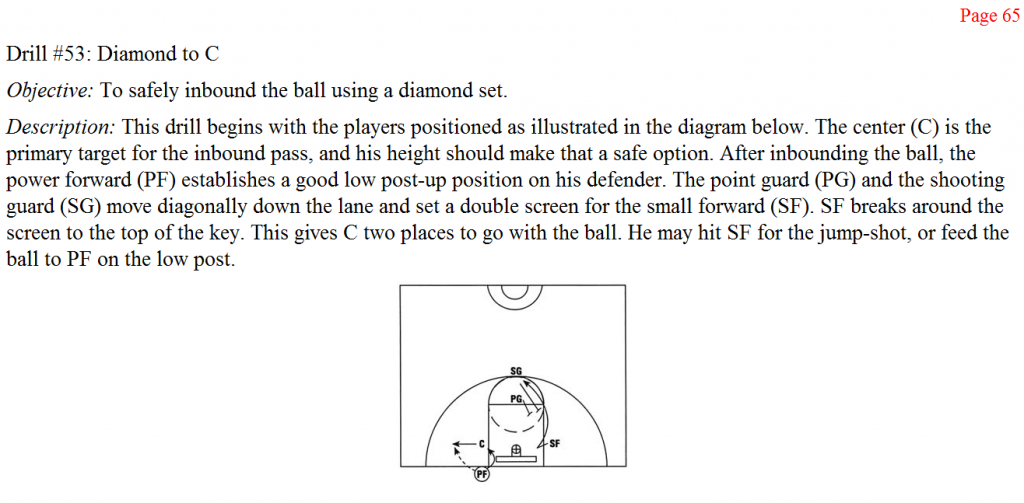
Drill #53 is quite simple. Straight up, your team will use a double screen to sweep out the free throw circle and make a switch at least difficult, creating space for a jumper from the top of the key. And if the defense eventually switches on the double screen, the two big men (conveniently located at the baseline) can start a solid post-up or lob situation as a fine second option.
It's very simple, yes, but note the subtleties of resource management: a double screen is about creating a wall of space more than it's about size*, so the size (PF and C) goes to making and receiving the inbounds pass. The center flares out to give him space to receive the inbounds pass but also to give him an angle to the top of the key. The power forward runs a suggestive route with an establishing cut, so the defender can't avoid the lob question. At best, PF's defender is looking at a battle in the post and not much else.
*Spurs fans might note that Popovich will often use double back-screens (with basically random players like RJ/Bonner/Hill) at the basket to allow Duncan to curl around for an easy two. One rather stark example is easily seen in Sebastian Pruiti's solid breakdown.
And that's just on the inbounds pass. The second pass from C-SF "starts" at the beginning of the play as a dangerous interior cross-court pass, right across the blocks, and when the SF v-cuts into the lane, the pass becomes just plausible enough to have to defend. An option Karl could have added would be an actual cut to the basket for a lob, and you have to think that the SF has to be a lob threat or a threat under the basket for this to work. But despite all of this, the "end game" of the pass is a relatively simple, uncontested pass between two players that have flared to safe spaces.
One of the reasons this review took so long to post was just the simple challenge that I had in making .gifs that didn't look like a child had drawn them -- specifically, a child like myself, with conspicuously poor motor skills and even more questionable design skills. If you must know the whole story of the .gifs, check out their alt-texts. Anyway, here are the .gif files, one for each option.
Anyway, both of these plays are fairly simple to execute and differ only in that in the second version, the SF hasn't gotten open, so the C goes to the PF as the second option.
Drill #19
Well, I chose one simple drill above: Now it's time for one hilariously convoluted (but possible) one.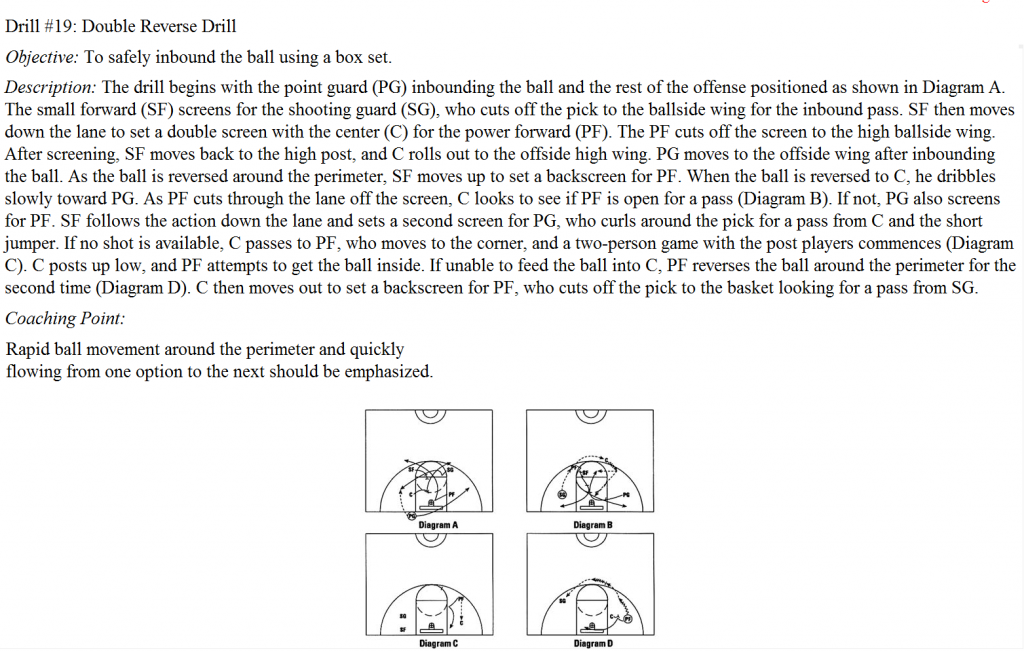
Now, this drill is exactly as complicated as it looks. Just look at it: It's that complicated. It's probably the most complex and complicated drill in the book, for those of you into maddeningly pedantic distinctions. And there's no "use a screen as a means of confusion". This drill seems to assume that the defense will make perfect rotations. For my part I've only seen a few perimeter possessions where the defense honestly would stand a chance against this play if executed correctly. The only weaknesses I see are: its complexity, its dependence on dozens of quick passes, its length (it might be possible to execute the fourth option in 7 seconds, but realistically, this is an entire 14 or 15 second play).
To understand this drill it's important to see it in real time, as visualizing the above play takes quite a while from the book's description and diagrams. This is a cool thing if you're a reader trying to understand the geometry of basketball. It's not so cool if you're trying to convey the motion of this play to a blog reader. My final version of the fourth option .gif had 44 separate frames, almost all of which consisted of a screen or a perimeter pass, despite the staggered motions inherent to stop-motion animation. It's a very busy play involving all five players.
Above is the first option. The SF basically greases the wheels with three screens in the lane (and the center makes two screens on his way to the wing, too). This isn't a play built on deception, really. The SF stays around the elbow after the double screen for the PF to set a back-screen for that same PF. You can account for that, but you're asking the defense to make switch after switch, switching even as a switch is in progress. Note also that the center's pass in is essentially an open lob or an oop if the PF is open. Not all frontcourts are capable of this, but for me this immediately brings to mind set plays involving David Robinson and Tim Duncan.
In the second option the point guard comes from the wing and curls around and flares out off of a SF screen to the open jumper at the FT line. Notice that this second option is set up by the PG and SF following the PF into the lane from the first option. It's not hard to see a simple variation to salvage the first option in which the PG screens for the PF in a second attempt to allow the C-to-PF play, perhaps instead for a five-footer at the block. In either case, the PG can quickly finish the screen and end up with space for a jumper. But the PG-to-PF screen serves a second purpose:
For the third option, the pass to the PG wouldn't yield an open shot, so the C feeds the PF in the post and comes down to help for a two-man game. So long as the PF isn't dribbling and there's time on the shot clock, the PF can basically just hold while the C comes down to screen.
Astonishingly, as you can see, Karl includes yet a fourth option for this play: Supposing the two-man PF-C game doesn't work, the PF can reverse the ball around the perimeter again and immediately cut for the other side of the basket "around" the defense to complete the reverse. Notice that even here (on the fourth option of the play) there are other variations that could easily have worked and been incorporated: A SF jumper, (reward for all those screens in the first part, maybe!) a two-man game on the baseline with the SF-PF or on the wing with SG-PF, or a jumper at any point in the second reverse.
Yes, this play is mighty complicated, with a lot of moving parts and a lot of assignments. But it is also robust and expressive enough to encapsulate much of an offense's skill, is plenty able to be modified to reflect the different advantages and disadvantages that an offense might possess (as it is, this play with its lobs and center decision making seems more at home with a great frontcourt like Tim Duncan/D-Rob surrounded by decent shooters with limited driving ability).
• • •
Conclusion
It's hard to call George Karl an innovator - a... bridgelayer, so to speak - without having a robust knowledge of what came before. I've not heard him been mentioned in those terms before, so it may be safe to assume not. But whatever the case, it's just as hard to deny that George Karl is an incredibly solid coach in sheer basketball terms that has brought every type of lineup to high levels of achievement in his career. You get the sense that it doesn't matter all that much what players he has at his disposal: he will find a way to get the most out of them (though, of course, every player and lineup's ceiling is different) most of the time. There are no doubt clearer playbooks out there, and there are in all likelihood quite a few coaches that are right at Karl's level, or even better. But this book gave me a little insight into how he thinks, and that's a story worth telling. Hope you enjoyed listening.

